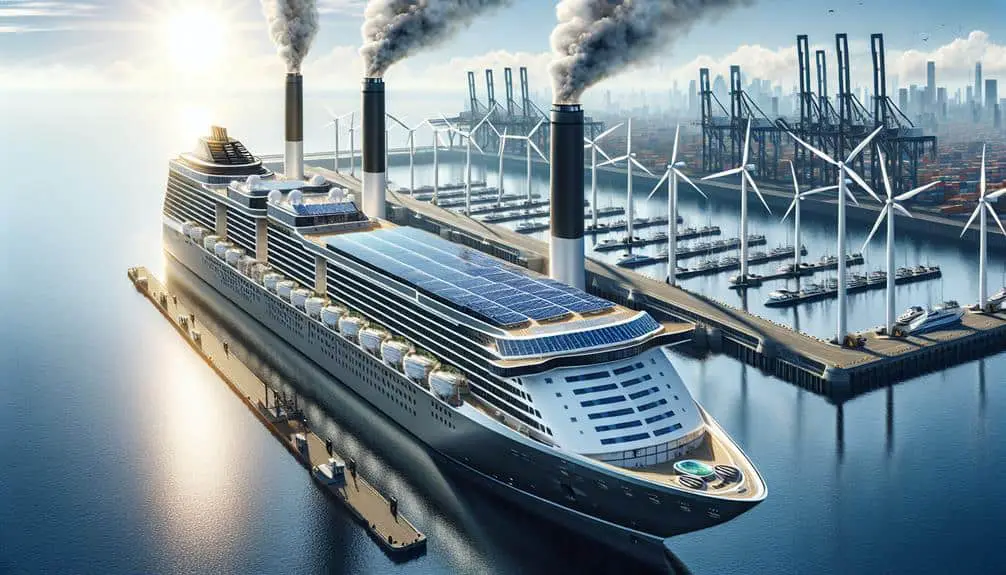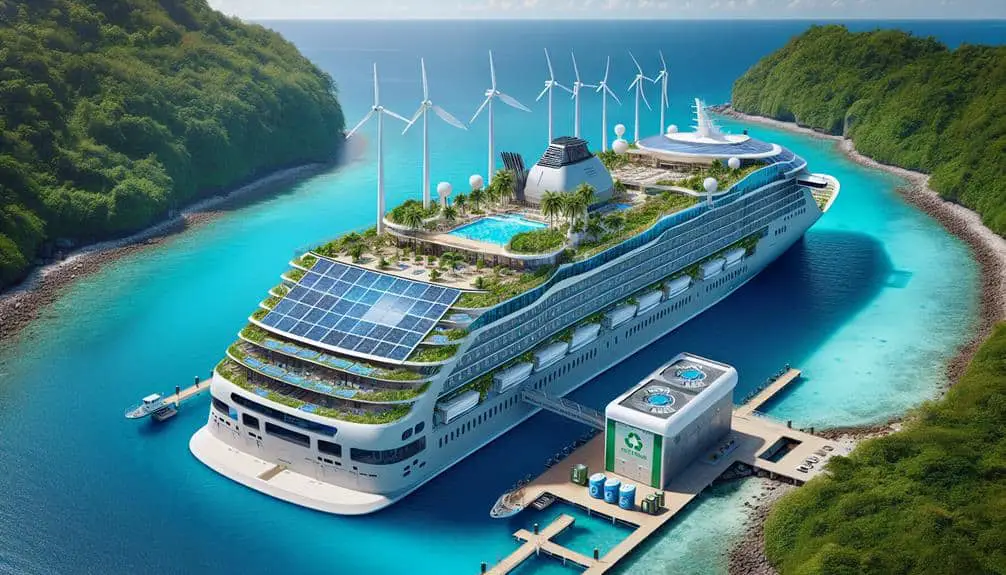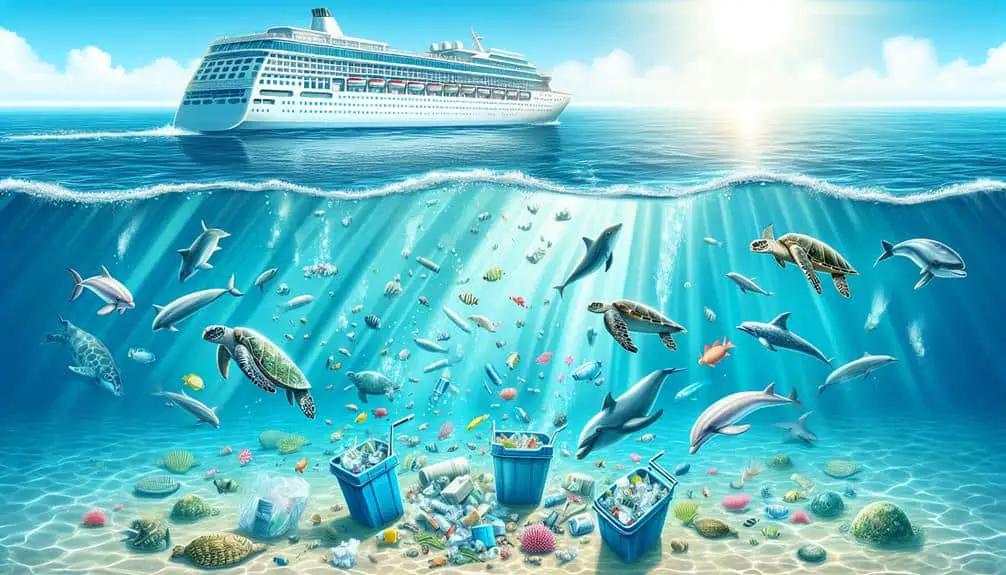Implement advanced wastewater treatment systems for removing harmful contaminants. Utilize shore power technologies to reduce emissions while docked. Opt for low-sulfur fuel alternatives to decrease pollutants like sulfur oxides. Enhance waste management with recycling and composting programs. Promote energy-efficient operations through sustainable practices. These practical tips effectively reduce cruise ship pollution.
Key Points
- Implement advanced wastewater treatment systems for effective pollutant removal.
- Utilize shore power technologies to reduce emissions while docked.
- Opt for low-sulfur fuel alternatives to decrease sulfur oxide emissions.
- Enhance waste management practices through recycling and composting.
- Promote energy-efficient operations with LED lighting and advanced propulsion systems.
Implementing Advanced Wastewater Treatment Systems
To greatly reduce cruise ship pollution, implementing advanced wastewater treatment systems is imperative due to their proven effectiveness in removing harmful contaminants.
Sustainable design principles must be at the forefront of these systems to guarantee environmental responsibility. Research indicates that advanced treatment technologies, such as membrane bioreactors and advanced oxidation processes, are highly efficient in treating wastewater onboard cruise ships.
These systems not only meet but exceed regulatory compliance standards, safeguarding the marine environment from pollution.
Using Shore Power Technologies
Shore power technologies offer a promising solution for reducing cruise ship emissions and minimizing environmental impact while docked. By enabling ships to connect to the local electrical grid while in port, these technologies allow vessels to power down their engines, greatly reducing emissions of harmful pollutants like sulfur oxides, nitrogen oxides, and particulate matter. This simple yet effective solution not only improves air quality in port areas but also helps in achieving emission reduction targets set by regulatory authorities.
To fully leverage shore power technologies, it's vital for ports to invest in the necessary infrastructure. Ports need to equip docks with the appropriate electrical connections to accommodate different types of ships, ensuring a smooth transition to shore power for all vessels. Additionally, establishing standardized protocols and guidelines for the use of shore power can further enhance its effectiveness in reducing emissions. By prioritizing the implementation of shore power technologies and improving port infrastructure, the cruise industry can make significant strides towards a cleaner and more sustainable future.
Opting for Low-Sulfur Fuel Alternatives
When considering ways to further reduce cruise ship emissions and environmental impact, one effective strategy is opting for low-sulfur fuel alternatives. Sustainable practices in the maritime industry are essential for mitigating the environmental impact of cruise ships.
Low-sulfur fuel alternatives, such as marine gas oil with reduced sulfur content, have shown promising results in decreasing sulfur oxide emissions. Research indicates that using low-sulfur fuels can lead to a significant reduction in air pollutants like sulfur dioxide, which contributes to acid rain and poses health risks to both humans and marine life.
Implementing low-sulfur fuel alternatives is a proactive step towards achieving a more sustainable cruise industry. By choosing cleaner fuel options, cruise lines can actively reduce their carbon footprint and limit the harmful effects of air pollution on the environment.
Investing in these environmentally friendly practices not only aligns with regulatory requirements but also demonstrates a commitment to responsible environmental stewardship. Embracing low-sulfur fuel alternatives sets a positive example for the industry and promotes a healthier future for our oceans and coastal communities.
Enhancing Waste Management Practices
Enhance cruise ship sustainability by implementing innovative waste management practices that minimize environmental impact and promote responsible stewardship. To achieve this, consider the following:
- Recycling Initiatives: Implement thorough recycling programs onboard to guarantee that materials such as paper, plastic, glass, and aluminum are properly recycled. Set up designated recycling bins throughout the ship to encourage passengers and crew to participate actively.
- Waste Reduction Strategies: Introduce measures to decrease waste generation onboard. This may include initiatives like promoting the use of refillable water bottles, providing digital versions of materials to reduce paper usage, and partnering with suppliers to minimize excess packaging.
- Composting Programs: Establish composting programs to manage organic waste efficiently. Composting can greatly reduce the volume of waste produced onboard while also creating valuable compost for use in landscaping or onboard gardens.
- Incineration Alternatives: Explore alternative methods to traditional waste incineration that may produce harmful emissions. Consider investing in advanced waste treatment technologies that prioritize environmental sustainability.
Promoting Energy-Efficient Operations
To maximize operational efficiency and reduce energy consumption on cruise ships, consider implementing advanced technologies and sustainable practices. Energy conservation plays an important role in promoting environmentally friendly operations within the cruise industry. Utilizing innovative solutions such as LED lighting, advanced propulsion systems, and waste heat recovery can greatly reduce energy usage onboard.
Sustainable practices like optimizing HVAC systems, utilizing shore power when available, and implementing energy management systems can further enhance energy efficiency.
Research indicates that energy-efficient operations not only reduce the environmental impact of cruise ships but also lead to cost savings for cruise lines in the long run. By investing in energy-efficient technologies and practices, cruise ships can lower fuel consumption and greenhouse gas emissions, contributing to a more sustainable maritime industry.
Frequently Asked Questions
Are There Any Regulations in Place to Monitor and Enforce Cruise Ship Pollution Reduction Measures?
Regulatory compliance is essential for monitoring pollution reduction on cruise ships. Enforcement measures, such as fines and inspections, guarantee adherence to environmental standards. With 80% of cruise ships compliant, ongoing vigilance is critical for sustainability.
How Do Cruise Lines Ensure That Their Waste Management Practices Are Environmentally Friendly and Comply With Regulations?
To guarantee waste management practices align with regulations and are eco-friendly, cruise lines implement advanced onboard systems, conduct regular audits, and invest in sustainable technologies. Environmental compliance is a top priority for the industry.
What Are Some Potential Challenges or Obstacles That Cruise Lines Face When Trying to Reduce Their Environmental Impact?
Steering through challenges, cruise lines face obstacles like cost constraints, technology limitations, and regulatory complexities. Overcoming these hurdles demands innovative implementation strategies and sustainable solutions to reduce environmental impact effectively while staying compliant with regulations.
Are There Any Financial Incentives or Benefits for Cruise Lines That Invest in Pollution Reduction Technologies?
Investing in pollution reduction technologies can bring financial incentives like tax credits or rebates. Beyond monetary gains, cruise lines benefit from improved public relations, operational efficiency, and compliance with regulations. Environmental benefits are evident and vital.
How Do Cruise Lines Communicate Their Environmental Efforts and Progress to the Public and Their Customers?
To communicate environmental efforts effectively, cruise lines engage customers through green marketing strategies, display environmental certifications prominently, and publish sustainability reports. Transparent and informative communication fosters trust and shows commitment to sustainability goals.




